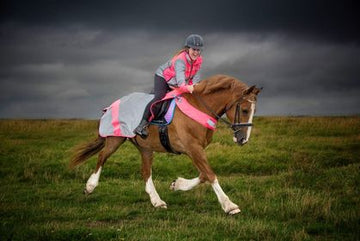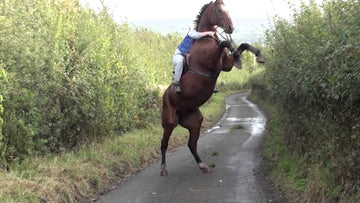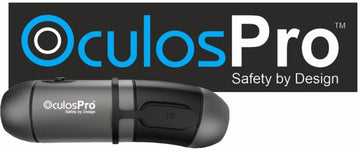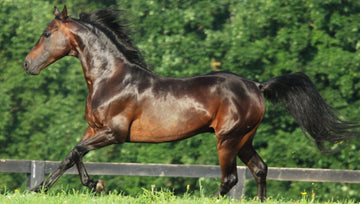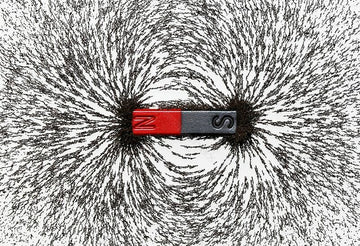Horses and ponies are unpredictable animals and it can be hazardous to be around them at times. So, here are a few tips on how to act to remain safe.
General Safety
Safety involves common sense and an understanding of horses. Horse riding can be high-risk, but handling horses from the ground can be just as dangerous. Also, equestrian activities often involves lifting and carrying heavy items, so break them into manageable weight loads and utilise safe lifting techniques to prevent back injuries.
Clothing and equipment
It goes without saying that sensible clothes must be worn when around horses. A hat/helmet is essential when riding, and a body protector is also a good idea. It is imperative that both these items meet the correct safety standards and should be correctly fitted and purchased from a reputable retailer. The wearing of jewellery is inadvisable as items can get caught and cause injury.

Understanding horses
Never take a horse’s behaviour for granted as even the oldest and quietest horse can behave unpredictably. The natural instinct of a horse dictates either “fight or flight” as a defence reaction if feeling threatened. Therefore when around horses, the following tips are worth following:
- Be insured – public liability insurance is essential for all horse owners, keepers or riders as claims may be made against them in the event of an accident
- Stay alert – consider how your horse is likely to react, and take positive action before your horse becomes alarmed
- Confidence is key – a horse takes confidence from a confident handler
- Ground rules – stick to them consistently but ensure they are realistic
- Seek help and guidance when necessary – there is always something new to learn and someone who is more experienced
- Think “prevention” – complacency causes accidents so don’t take unnecessary risks
Being on the yard
Human and equine first aid kits should be readily available on your yard plus someone should be qualified in first aid practises. All keepers and visitors to the yard should be made familiar with accident procedures and know what action to take in the event of an emergency.
A list of emergency contact numbers should be displayed prominently and programmed into the mobile phones of riders in case of accidents when out riding. An emergency list should include details of the yard manager, a veterinary surgeon, doctor, farrier, the local police and the fire brigade.
Main yard gates should be kept closed at all times to reduce the risk of a loose horse escaping onto the road. Ensure stable doors are fastened securely with horse-proof locks and that all areas to which horses have access are free from impediments and any surfaces that may cause accidents or injuries.

On the ground
Horses should be taught basic commands and how to respond accordingly, most importantly how to stand still and walk clear of the handler when being led from either side. Handlers should wear gloves when leading, and lead ropes/lunge lines should not be wrapped around the hand or allowed to trail on the ground.
When being groomed, tacked-up or even in a stable ensure the horse is tied up, this will allow the handler to move quietly and confidently without the danger of being trapped in a corner.
The horse should wear a well-fitting head collar when tied up, with the lead rope secured through a loop of string attached to the tying-up ring. This means if the horse panics and pulls back, the string will break, minimising the chance of the horse slipping over and becoming injured. Do not tie a horse up by attaching the rope to the bit or tying the horse by its reins as it may cause serious injury.
Make sure you are in the safest position for the task you are carrying out. Standing directly behind or in front of a horse can increase the risk of being injured should the horse strike out with a limb. When holding a horse that is being clipped or treated by a veterinary surgeon or farrier, you should stand on the same side them.
When applying boots or bandages squat beside the horse (not sit or kneel), so you can move quickly should the need arise.
If you need to remove a head collar when turning a horse loose in the field or stable, first lead the horse in and then turn around to face the door or gate before being released. This was will lessen the risk of being trampled or kicked by an excited animal.
Totally Tack
All tack and riding equipment should be well maintained, correctly fitted and fit for purpose. It must be cleaned and inspected regularly for signs of damage, particularly to straps, stitching, buckles and fasteners.
Equally the rider should be suitably attired. The equipment should be checked before mounting and at intervals during a ride. The girth should be comfortable for the horse and fitted securely – an over-tightened girth can be just as harmful as a loose one.
A rider should never ride any horse which they are unable to safely control. To enable and new partnership to become accustomed with one another, schooling in an enclosed and familiar environment is favourable when schooling.
Road-Worthy
Riding on roads demands both common sense and road sense. All road users have a legal duty to be familiar with the Highway Code. Riders should be appropriately attired and, by law, children under 14 years of age must wear a hat complying with the Horses (Protective Headgear for Young Riders) Regulations 1992, although common sense must prevail here in that all riders should wear one.
Riders should be observant and acknowledge careful drivers. Both hands should be kept on the reins, except when signalling changes of direction. When leaving the yard all riders should leave details of their planned route and the time at which they should be expected back.
It is advisable to wear fluorescent/reflective apparel at all times when riding, whether on roads, country lanes, bridleways and fields. Riding in poor visibility should be avoided if possible. However, even on a bright, sunny day horse and rider can be difficult to spot, owing to the contrast of light and shade and the glare and reflection from the sun. Irrespective of conditions, it should never be taken for granted that you have been spotted by the driver of an approaching vehicle. Should you have an accident whilst out in the countryside, wearing hi-vis will enable emergency services to locate you.

A less experienced horse or rider will benefit from being accompanied by an experienced rider on a sensible horse. A horse known to be dangerous in traffic should not be ridden on the road until appropriately trained in safe surroundings by an experienced trainer.
In accidents involving cars and horses, the horse and rider invariably come off worse. Riders should know what action to take in the event of an accident and should report accidents and also any near misses to the local police.
If an accident occurs:
- Prevent further accidents and risk of injury by warning approaching traffic
- Summon professional help and emergency services
- Apply basic first aid (to humans and horses) until help arrives
- Inform the police if there are horses loose on the road.
Fire hazards
The most terrifying danger in the stable yard is fire. Stables have an abundance of flammable material, and fires can spread rapidly. All yards should have a strict no smoking policy and the use of unprotected (naked) flames as sources of heat should be avoided. Cobwebs should not be allowed to accumulate in and around stables, and yards and walkways should be kept free of discarded hay and bedding.
Fire procedures and equipment should be well maintained and serviced regularly. Remember, fire extinguishers are a vital piece of safety equipment and must be stored properly (not used as door stops).
Action in event of a fire
- Dial 999 and ask for the fire service. The caller should give their name, address of the premises, telephone number and postcode (this is most helpful and should be displayed on all fire safety signs)
- Ensure that the access route is clear for the arrival of the fire service
- Sound the alarm and follow evacuation procedures, first removing those horses closest to the fire and taking them to a secure place of safety, out of reach of the fire.
- Lead loose and frightened horses to a place of safety.
- Attempt to fight small fires only if they can be contained immediately and appropriate equipment is to hand
- Protect human and then animal life as the priority. Buildings and equipment, though valued, can be replaced.
Photo of riding hat courtesy of Uvex.

